We’ve mentioned that we prepare a soup broth every weekend and have soup as the first course of dinner most days of the following week.
But we haven’t mentioned that it’s possible to have a slightly different soup every night of the week. Here’s how.
The Broth
One of our favorite broths is a beef broth soup made from ox feet. First, find an Asian supermarket and buy some ox feet:
The ox feet will have been sawed so that collagen and sinews are exposed and can dissolve in the broth.
The longer you cook it, the more nutritious the broth gets. Here’s what it looks like after 3 hours:
There’s some fat on the top, which is delicious! You can also add some dried anchovy to the broth — say 10 anchovies per gallon — which we think improves the flavor.
When you eat the soup, be sure to eat the gelatin off the cooked ox feet. According to Ray Peat, this is very good for you.
The broth can serve as the base for a wide range of soups. Here are some of the ones we make.
Miso Soup
Miso is a classic Japanese soup. To make it, you’ll need Wakame seaweed and miso paste. The Wakame seaweed can be purchased at Amazon.com (see our supplement page).
Wakame seaweed expands about five-fold in water, so use the dried seaweed judiciously. Set some aside to soak and expand in water:
Here we’ve also put some kelp (kombu) in the water. That’s the brownish square on the right. Kelp is much less tasty than wakame, but has more iodine.
Put some of the ox feet broth with a few ox feet in a smaller pot for the evening’s soup. Here the broth includes some dried anchovies:
Put aside a small amount of the broth in a bowl and dissolve the miso paste in the broth. Make sure it is thoroughly mixed before returning it to the pot:
After the seaweed has expanded, add it to the soup and cook for half an hour. When it’s nearly done, add miso paste and scallions and cook another 5 minutes. It’s now ready to eat:
Other Choices
You can add any other ingredients you like to the broth to make soups of different flavors.
Here we’ve added diced potato, shiitake mushrooms, and scallions:
Here we’ve added egg, tomato, and scallion:
Here we’ve added sliced ribeye beef, enoki mushrooms, and cilantro. Since thin-sliced beef and enoki mushrooms cook very quickly, you can treat this like a Vietnamese “pho” and simply put the beef and mushrooms in a bowl and pour the hot broth over them:
The making of the broth is the only time-consuming part of this. After the broth is prepared on the weekend, new soups can be prepared in 15-30 minutes. Season each soup with salt, pepper, and your favorite spices.







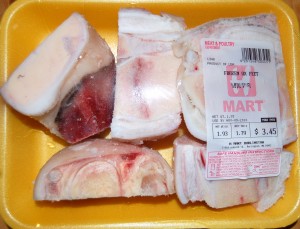
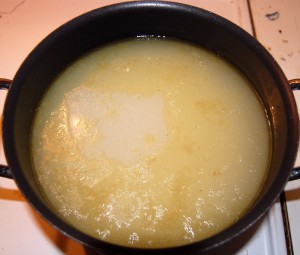
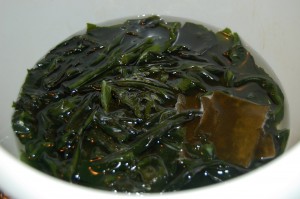
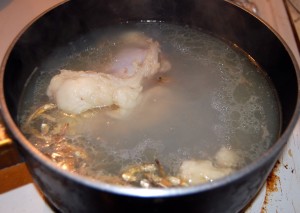
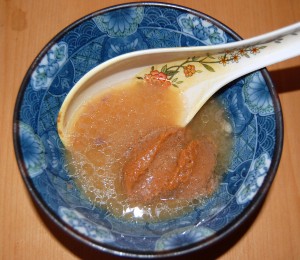
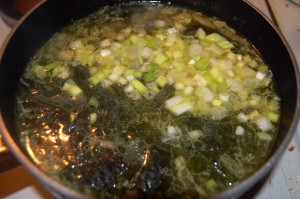

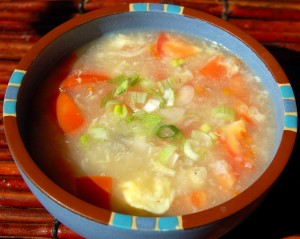
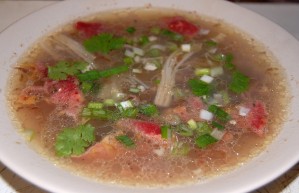




Paul,
I too am curious about pressure cooking stock and other meats and would love if you could comment more on the effects of pressure cooking on nutrients and toxin formation. This article is interesting: http://www.foodrenegade.com/pressure-cooking-healthy/
Hi Elliott,
Pressure cooking is possible but we like stovetop cooking of bones better. The bones tend to disintegrate and collagen dissociate in the pressure cooker.
Thanks for sharing, and the pictures are so helpful! How much water do you add, just enough to cover the bones?
Also, do you cook with the lid of or off? And do you add more water as the original water cooks away?
Hi Jennifer,
Yes, just enough water to cover the bones. Bring the water to a low boil and maintain a simmer with the lid on at the lowest possible heat. The lid keeps water from evaporating so that the bones remain covered.
Hi Paul, thank you for the recipes, they look amazing! I’m a big fan of bone broth, and miso. However, it’s my understanding that you don’t want to boil miso- it’s a fermented food and boiling kills the healthy bacteria, what are your thoughts?
HI,
when you’re cooking brooth with bones and some bone-attached-meats – is it possible to refregerate cooked bones and meats to use theme again with the next batch?
When I look at the meats like beef-ribs, oxtail or chicken-legs after cooking a bactch of brooth there seems to be a lot of undisolved gelatin-rich material. Of course there is also some meat.
Is it recommended repeat some cook-refergerate-cycles?
is it safe?!
It’s not a question of cost. Just don’t want to waste ingredients …
(Brooth with beef- and chicken-bones: 3 hours simmering, then 6-10 resting without any heat)
Hi Paul, I came here from the pinterest board and see this recipe was posted a few years back, and recall that your broth-making method more recently involved discarding the first boil and restarting – do you still feel that is better, or is straight boiling as described here ok? Also wondered about use of miso, since it’s soy, and as well about the boiling of the fermented miso which would compromise the beneficial bacteria. Thanks in advance!
Hi Teresa,
Yes, we now prefer cleaning the bones with a flash simmer and discarding that dirty water.
Miso is OK. It’s OK to lose the bacteria in boiling, we are most interested in the fermentation products which survive, not the bacteria or yeast.
Best, Paul
Can anyone help with what Paul means by this?: “We typically will 4-5 rounds with each set of bones”
It just means you can re-use the bones up to 4-5 times. The stock gets thinner each time.
Thanks, Paul.
I also found your other post, which gives lots of great detailed information about making bone broths:
http://perfecthealthdiet.com/2011/10/bone-broth-revisited-and-pumpkin-soup/
I can’t thank you enough for sharing your life-changing wisdom so generously.
Paul, I’m sure I recently read a post of yours about cooking bone broth in your instant pot?!! I’ve tried looking for it but can’t seem to find it. Previously I’ve done it in the slow cooker. Delicious. But I would love it if you could help me with the instant pot post as I’ve just bought one and I would like to try it. You had some good info on it too. As a side note and probably too much info.!!! I have suffered from chronic constipation for a number of years and nothing has seemed to work long term. A cup of bone broth each morning and voila! So far I’m as regular as. If this continues this will be a huge health benefit to me. Thank you. Have read your book and making changes to my diet. It’s a lot to take in. Thank you again.
Hi Peta,
Bone broth can be made in the Instant Pot, but we generally do it on the stove. Here are the relevant posts: http://perfecthealthdiet.com/category/food/soups/
With a pressure cooker it’s easy to overheat and degrade the bones, potentially creating inflammatory amines and impairing the taste. We haven’t done enough work to find a method we like in the Instant Pot.
Re constipation, see https://perfecthealthdiet.com/2011/04/causes-and-cures-for-constipation/. Bone broth is rich in glycine which may be the reason it helps.
Best, Paul